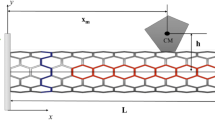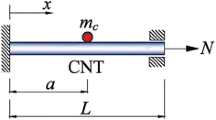Abstract
In this study, we used the Finite element method (FEM) based on continuum mechanics, instead of molecular dynamics, to design and analyze an ultra-small mass nanomechanical sensor using Single wall carbon nanotube (SWCNT). We tested the validity of the FEM modeling technique based on continuum mechanics by comparing its analysis results with those of molecular dynamics modeling. After developing an elastic continuum shell model having an effective thickness, Young’s modulus, and Poisson’s ratio, we proved the superiority of the implemented analysis technique by comparing its resonance frequency with that of the molecular dynamics model. Additionally, using the developed model, we established various design parameters for a resonator and observed the parameter-dependent changes in frequency characteristics of the resonator.
Similar content being viewed by others
References
S. Iijima, Helical microtubules of graphitic carbon, Nature, 354 (1991) 56–58.
J. Yoo, S. Cho, W. Kim, J. Kwon, H. Kim, S, Kim, Y. Chang, C. Kim and D. Choi, Effects of mechanical deformation on energy conversion efficiency of piezoelectric nano generators, Nanotechnology, 26 (2015) 275402.
A. Y. Joshi, S. P. Harsha and S. C. Sharma, Vibration signature analysis of single walled carbon nanotube based nanomechanical sensors, Physica E, 42 (2010) 2115–2123.
R. Chowdhury, S. Adhikari and J. Mitchell, Vibrating carbon nanotube based bio-sensors, Physica. E, 42 (2009) 104–109.
R. Gao, Nanomechanics of individual carbon nanotubes from pyrolytically grown arrays, Phys. Rev. Lett., 85 (2000) 622–625.
V. Sazonova, Y. Yaish, H. Üstünel, D. Roundy, T. A. Arias and P. L. McEuen, A tunable carbon nanotube electromechanical oscillator, Nature, 424 (2003) 408–410.
S. Sawano, T. Arie and S. Akita, Carbon nanotube resonator in liquid, Nano. Lett., 10 (2010) 3395–3398.
K. Jensen, J. Weldon, H. Garcia and A. Zettl, Nanotube radio, Nano. Lett.,7 (2007) 3508–3511.
M. Dai, K. Eom and C-W Kim, Nanomechanical mass detection using nonlinear oscillations, Applied Physics Letters, 95 (20) (2009) 203104.
D. Kang, H. Yang and C. Kim, Thermal effects on mass detection sensitivity of carbon nanotube resonators in nonlinear oscillation regime, Physica E, 74 (2015) 39–44.
S. B. Legoas, V. R. Coluci, S. F. Braga, S. O. Dantas and D. S. Galvão, Molecular-dynamics simulations of carbon nanotubes as gigahertz oscillators, Phys. Rev. Lett., 90 (2003) 055504.
C. Li and T.-W. Chou, Mass detection using carbon nanotubebased nanomechanical resonators, Appl. Phys. Lett., 84 (2004) 5246.
X. Chen and G. Cao, A structural mechanics study of singlewalled carbon nanotubes generalized from atomistic simulation, Nanotechnology, 17 (2006) 1004–1015.
C. Li and T.-W. Chou, Elastic moduli of multi-walled carbon nanotubes and the effect of van der Waals forces, Comput. Sci. Technol., 63 (20030) 1517–1524.
C. Q. Ru, Effective bending stiffness of carbon nanotubes, Phys. Rev. B, 62 (2002) 9973.
C. F. Cornwell and L. T. Wille, Elastic properties of singlewalled carbon nanotubes in compression, Solid State Commun., 101 (1997) 555.
E. W. Wong, P. E. Sheehan and C. M. Lieber, Nanobeam mechanics elasticity, strength, and toughness of nanorods and nanotubes, Science, 277 (1997) 1971.
T. Vodenitcharova and L. C. Zhang, Effective wall thickness of a single-walled carbon nanotube, Phys. Rev. B, 68 (2003) 165401.
H.-Y. Chiu, P. Hung, Henk W. Ch. Postma and M. Bockrath, Atomic-scale mass sensing using carbon nanotube resonators, Nano. Lett., 8 (2008) 4342–4346.
A. Pantano, D. M. Parks and M. C. Boyce, Mechanics of deformation of single-and multi-walled carbon nanotubes, J. Mech. Phys. Solids, 52 (2004) 789–821.
C. Li and T.-W. Chou, Vibrational behaviors of multiwalledcarbon-nanotube-based nanomechanical resonators, Appl. Phys. Lett., 84 (2004) 121.
D. Garcia-Sanchez, A. S. Paulo, M. J. Esplandiu, F. Perez-Murano, L. Forró and A. Bachtold, Mechanical detection of carbon nanotube resonator vibrations, Phys. Rev. Lett., 99 (2007) 085501.
A. Salehi-Khojin, S. Bashash, N. Jalili, M. Müller and R. Berger, Nanomechanical cantilever active probes for ultrasmall mass detection, J. Appl. Phys., 105 (2009) 013506.
Author information
Authors and Affiliations
Corresponding authors
Additional information
Recommended by Associate Editor Heung Soo Kim
Chang-Wan Kim received a Ph.D. in NVH analysis by newly developing Automated Multilevel Substructuring (AMLS) method from the University of Texas at Austin. AMLS is now being used in all automobile industries for NVH analysis. He previously worked in NASTRAN developer in USA and RecurDyn in Korea. He has over 80 paper publications along with several invited papers and presentations. Now, his research is specialized in multiphysics analysis by integrating CFD-MBD-FEM technology.
Rights and permissions
About this article
Cite this article
Cho, SH., Choi, MS., Kang, DK. et al. Analysis on mass sensing characteristics of SWCNT-based nano-mechanical resonators using continuum mechanics based finite element analysis. J Mech Sci Technol 29, 4801–4806 (2015). https://doi.org/10.1007/s12206-015-1027-8
Received:
Revised:
Accepted:
Published:
Issue Date:
DOI: https://doi.org/10.1007/s12206-015-1027-8




